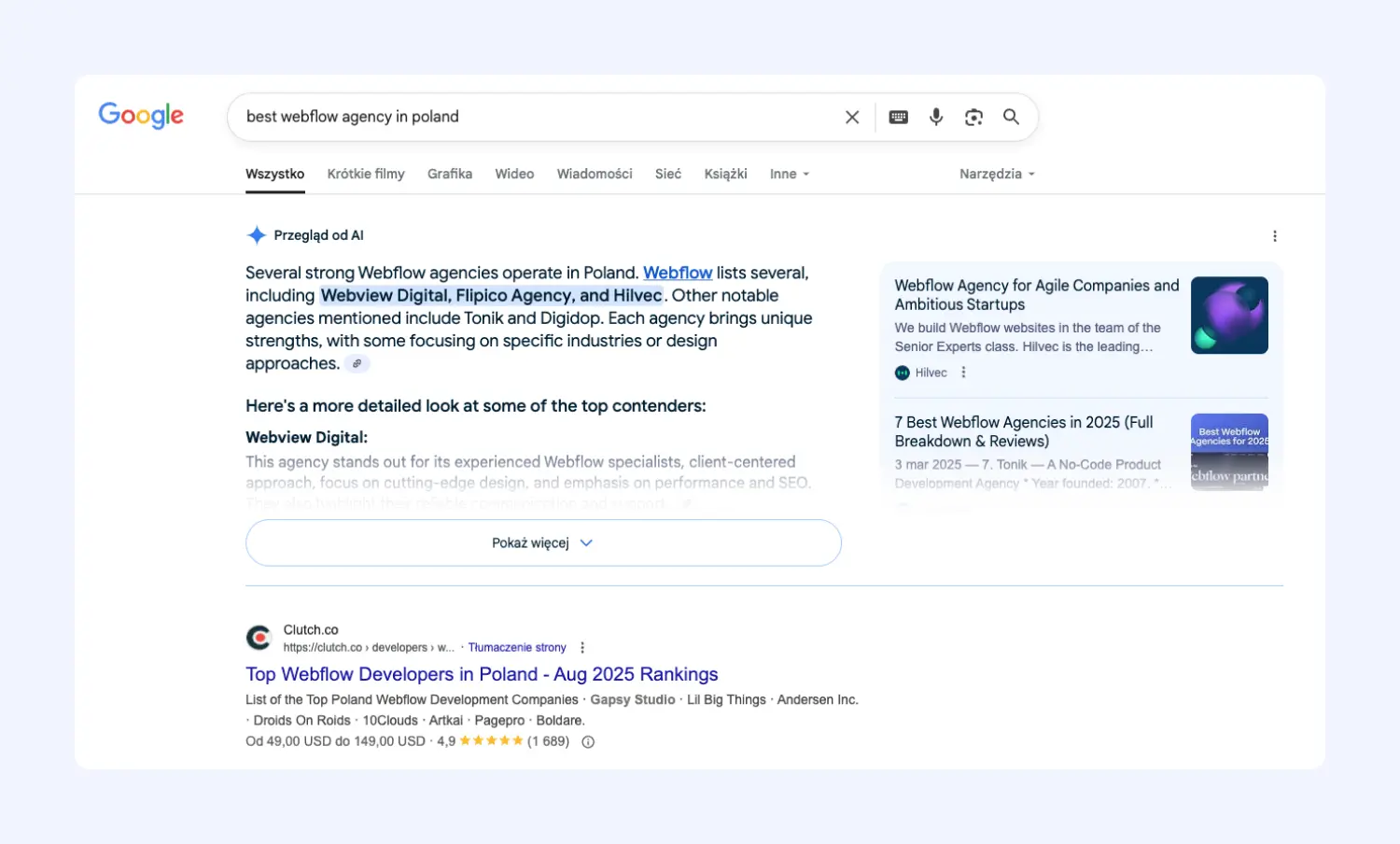Attracting customers to the company has never been easy. When competition in the network is growing every hour and customers have dozens of alternatives at hand, this task becomes even more difficult. In addition, there is a rapid technological change — not so long ago we adapted to the realities after the pandemic, now the use of digital tools and automation, including those based on artificial intelligence, is becoming crucial.
Online presence alone is not enough. You have to be able to stand out — by content, user experience, speed of reaction. And for this you need a specific strategy and tools that keep up with the modern client.
Take care of the appearance and usability of your website
Entrepreneurs who have a well-designed website still have an advantage — but today that advantage depends not only on the design, but also on the technology that works underneath. The site must be fast, functional and intuitive.
More and more companies are implementing tools on websites that analyze user data, test different variants of content or predict which offers have the best chance of conversion. Many of them are based precisely on artificial intelligence - it works in the background, but it really increases the chance of sales. For example:
- Hotjar and Microsoft Clarity show you where users click, where they stop and when they leave.
- Optibase (for Webflow) or VWO allow you to test different versions of buttons, headers or entire sections of the page.
- Surfing SEO or Phrase help create content that better answers users' questions — also in the context of Google's AI Overview.
- Chat en vivo with automation, as Tidio whether Chatbase, will allow you to immediately respond to the user's doubts — without human participation, but with a human feeling.
Even if your site is already up and running and generating customers, that doesn't mean it can't perform better. Revision of the site is not just a visual issue. This is an opportunity to see if your content actually meets the needs of the user. Does the call to action still work? Are the forms understandable? Does everything work as it should on mobile devices?
For many customers, your website is the first — and often the only — place of contact with the brand. This is where the decision is made: “I stay” or “I click back”. This moment lasts fractions of a second.
According to research from the Missouri University of Science and Technology, users form an opinion about a website in less than 0.2 seconds. That's extremely little time to build trust — but enough to lose it. What can you do? Invest not only in appearance, but also in technology that from the first click guides the user by the hand and does not allow them to get lost. — and often the only — place of contact with the brand. This is where the decision is made: “I stay” or “I click back”. This moment lasts fractions of a second.
Classic SEO - a foundation that still works
A site that no one sees, does not sell. Even the best designed website won't do anything if it doesn't land on the first page of search results. This is why visibility is key. And this depends on a number of activities — from the selection of keywords, through technical optimization, to meaningful content.
SEO optimization today is a multi-layered process: loading speed, header structure, content hierarchy, internal and external linking, mobile-first design. Tools that support analysis and planning can help with all this — some of them use AI to prompt keywords, compare with competitors or automatically assess the quality of texts.
Valuable content, published regularly on a website or company blog, builds brand authority and increases its visibility on the web. The consumer is more likely to trust a company that not only sells, but also educates and helps solve problems.
AEO - Visibility in AI responses
More and more users are no longer entering queries only on Google. They look for answers in ChatGPT, Perplexity, Claude or the new Gemini from Google. It changes the rules of the game. Today, Google's search engine provides quick answers to queries called AI Overview.

Answer Engine Optimization (AEO) is the answer to this change. The idea is that your content is not only well positioned in the results, but also used as a source of response by AI models. How to achieve this?
- Create content in the form of clear questions and answers — FAQ is gold today.
- Write precisely and to the point. AI models are more likely to cite clear, concise statements than elaborate descriptions.
- Publish in sources that AI “reads” from — for example, well-built blogs, LinkedIn posts, articles on industry sites.
- Take care of the authority of the site — both in the eyes of Google (E-E-A-T) and in the structure of internal links.
AEO is today a real element in the struggle for user attention. Search doesn't start on Google anymore — and it often doesn't end there. The consumer is more likely to trust a company that not only sells, but also educates and helps solve problems.
Social media - relationship, not just reach
Social media today is not just a place for likes and photos from the office. It is a full-fledged sales and customer service channel — often more direct than a website. This is where customers comment, ask, praise... and complain. And they expect a reaction immediately.
A well-planned social media presence is primarily about regularity, consistency and responsiveness. But also the ability to listen. If the majority of your audience is B2B customers, you don't have to be everywhere. It is better to bet on LinkedIn and a well-run newsletter than on Instagram stories thrown in by force.
Instead of posting “on the fly”, it is worth using tools such as Buffer, Later whether Hootsuite — you will schedule publications there, analyze the results and quickly figure out what works. You can also use analytical tools such as Socialbakers or Brand24, which will tell you what topics are currently “on the wave” in your industry and where they talk about you.
And if you don't have time — it's better to post less often, but with meaning, than to spam empty posts. In social media, the same thing works as in life: relationships are built through value and authenticity.. But also the ability to listen. If the majority of your audience is B2B customers, you don't have to be everywhere. It is better to bet on LinkedIn and a well-run newsletter than on Instagram stories thrown in by force.
Advertising that actually sells
A well-set advertising campaign in Google Ads or Meta Ads is one of the surest ways to attract specific customers. The key is precision — you get to people who might really be interested in your offer.
The campaign is not a one-time shot. It's a process: testing creations, refining audience groups, optimizing budgets, and analyzing results. Tools that automatically suggest bids and optimize ad delivery can help — often using artificial intelligence that learns from thousands of previous campaigns.
If you are acting alone, reach for Google Keyword Planner, Biblioteca Meta Ads whether Canva Ads Plannerto better understand what works. Use remarketing campaigns — reminding people who have already visited your site about your offer.
For larger budgets — it is worth reaching for tools such as Revealbot whether Adzoom, which help you manage multiple campaigns and automate media decisions.
The second half of success is your strategy and your ability to interpret the data. Look not just at clicks — see which campaigns actually lead to conversions. Without it, even the best algorithms will burn your budget before you have time to sell anything.
A well-set advertising campaign in Google Ads or Meta Ads is one of the surest ways to attract specific customers. The key is precision — you get to people who might really be interested in your offer.
The campaign is not a one-time shot. It's a process: testing creations, refining audience groups, optimizing budgets, and analyzing results. Tools that automatically suggest bids and optimize ad delivery can help — often using artificial intelligence that learns from thousands of previous campaigns.
Don't underestimate email - it still works
Newsletters is one of the most converting sales channels — as long as it is conducted with the head. Mail goes straight to the inbox of the person who previously gave you permission to contact. It's someone who already knows you.
You don't have to write an e-book right away to get an email address. Sometimes a valuable checklist, a simple tutorial or a registration for a free webinar is enough. What matters is that the user has a reason to click “save me”.
Good email campaigns aren't just about offers — they're also about educating and reminding yourself at moments that make sense. Tools such as Mailerlite, Brevo (formerly Sendinblue) whether ActiveCampaign allow you not only to send emails, but also to build automatic communication paths - for example, for new subscribers or customers who have abandoned the cart.
It is also worth testing - different topics of messages, shipping times, length of content. Emails that are too general end up in the trash quickly. It is better to send less, but accurately, than to fill the inbox with empty passwords.
And then — to get more than just sales offers.
Service and loyalty - this is where the future wins
Getting a client is not the end of the game. This is just the beginning of a relationship that needs to be taken care of - if you want him to come back, recommend you further or... did not leave to the competition at the first opportunity.
Building loyalty is not magic, but a consequence of small actions. Sending a thank you for your purchase? Do you remember yourself after a month with valuable material? Surprise with a gift for a regular customer? This is how a relationship is created.
It's also worth listening to — literally. Ask the customer if everything went as expected. Ask for feedback. If something fails, react. No one expects perfection. But everyone appreciates commitment.
Finally, the most important
Building a strong online presence doesn't happen by accident. This is the result of many actions: a well-designed website, relevant content, thoughtful advertising, real contact with the customer and - where it is worth - the wise use of technology, including AI.
But in the end it's always about one thing: the relationship. If you can create it, you will win not only clicks, but also trust. And that's what decides who buys today — and who comes back tomorrow.
Start by looking at what you can improve right now. Maybe it's a headline on the page? Maybe the missing “thank you” after purchase? Small changes make a big difference.


.webp)